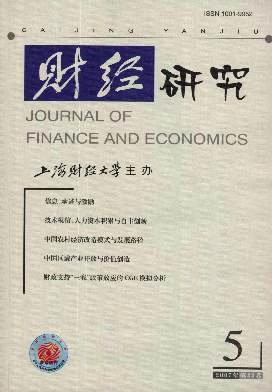信息、承诺与激励——理解中国农业生产激励变迁中的国家角色
财经研究 2007 年 第 33 卷第 05 期, 页码:5 - 18
摘要
参考文献
摘要
平均化的分配方式和退出权的剥夺导致人民公社内部的作物生产激励不足。但由国家管制政策引起的作物生产激励问题经常被研究者所忽略。文章发展了信息分权基础上的国家承诺分析框架,由于工业化目标,国家通过建立人民公社以降低治理成本,其中,人民公社承担了收集、处理作物种植信息并提取相应农业剩余的职能,从而导致人民公社面临严重的外部激励问题。20世纪70年代末期,财政困境促使国家放松对农业部门的组织化治理,允许以家户为单位的作物生产方法。这事实上放松了对作物生产的信息控制,由信息分权引起的国家承诺具有可信性,有效地增加了农民权利的安全性及其生产激励,构成农业部门生产效率改善的重要源泉。
[1]陈意新.困难时期安徽农民的生存问题[J].二十一世纪,2002,(8):49~58.
[2]高王凌.中国农民“反行为”调查[M].北京:中共党史出版社,2006.
[3]林毅夫等.中国的奇迹:发展战略与经济改革[M].上海:三联书店、上海人民出版社,1996.
[4]刘民权.你合作,我也合作[J].经济学(季刊),2003,(4):893~922.
[5]罗小朋.包产到户与土地集体所有制[A].文贯中.中国当代土地制度论文集[C].长沙:湖南人民出版社,1994.
[6]陶然等.农民负担、政府管制与财政体制改革[J].经济研究,2003,(4):3~12.
[7]王晓毅.小岗村的悖论[A].徐勇.三农中国[C].武汉:湖北人民出版社,2003.
[8]温铁军.中国农村基本经济制度研究[M].北京:中国经济出版社,2000.
[9]姚洋,支兆华.政府角色定位与企业改制成败[J].经济研究,2000,(1):3~10.
[10]张红宇.中国农村土地制度变迁[M].北京:中国农业出版社,2002.
[11]张乐天.告别理想:人民公社制度研究[M].上海:东方出版中心,1998.
[12]张宇燕,何帆.由财政压力引起的制度变迁[A].盛洪,张宇燕.从计划经济到市场经济[C].北京:中国财政经济出版社,1998.
[13]周其仁.中国农村改革:国家与所有权关系的变化[A].张曙光.中国经济学[C].上海:上海人民出版社,1994.
[14]Bai C et al.Limiting government predation through anonymous banking:A theory andevidence from China[D].CEPR Working Paper,1999,No.2221.
[15]Chinn L.Team cohesion and collective-labor supply in Chinese agriculture[J].Journalof Comparative Economics,1979,(3):375~394.
[16]Datta B,M Liu.Work incentives in a model of collective with and without universalmembership[D].Discussion Papers in Economics,University of York,1999,No.35.
[17]Dong X,Dow G.Does free exit reduce shirking in production teams?[J].Journal ofComparative Economics,1993,(17):472~484.
[18]Dong X,Dow G.Monitoring cost in Chinese agricultural teams[J].Journal of PoliticalEconomy,1993,101(3):539~553.
[19]Kung J.Transaction costs and peasants choice of institutions:Did the rights to exit re-ally solve the free rider problem in Chinese collective agriculture?[J].Journal of Com-parative Economics,1993,(17):485~503.
[20]Kung J,Putterman L.China’s collectivisation puzzle:A new resolution[J].Journal ofDevelopment Studies,1997,33(6):741~763.
[21]Laffont J,Qian Y.The dynamics of reform and development in China:A political econ-omy perspective[J].European Economic Review,1999,43:1105~1114.
[22]Lin Justin Y.The household responsibility system in China’s agricultural reform:Atheoretical and empirical study[J].Economic Development and Cultural Change,1988,36:199~224.
[23]Lin Justin Y.Collectivization and China’s agricultural crisis in 1959~1961[J].Journalof Political Economy,1990,98(6):1228~1252.
[24]Lin Justin Y.Rural reforms and agricultural growth in China[J].American EconomicReview,1992,82:34~51.
[25]Lin Justin Y,Yang Dennis T.Food avilability,entitlements and the Chinese famine of1959~1961[J].Economic Journal,2000,110:136~158.
[26]Liu M.Exit rights,retaliatory shirking,and the agricultural crisis in China[J].Journalof Comparative Economics,1993,17:540~559.
[27]Mead W.China’s agricultural reform:The importance of private plots[J].China Eco-nomic Review,2000,11:54~78.
[28]North D,Weingast B.Constitutions and commitment:The evolution of institutionsgoverning public choice in seventeenth-century England[J].Journal of Economic Histo-ry,1989,(4):803~832.
[29]Oi Jean.State and peasant in contemporary China[M].University of California Press,1989.
[30]Putterman Louis.Extrinsic versus intrinsic problems of agricultural cooperation:Anti-in-centivism in Tanzania and China[J].Journal of Development Studies,1985,21:175~204.
[31]Putterman Louis.Effort,productivity,and incentives in a 1970s Chinese People’s Com-mune[J].Journal of Comparative Economics,1990,14:88~104.
[32]Qian Y,Weingast B.Federalism as a commitment to preserving market incentives[J].Journal of Economic Perspectives,1997,11(4):83~92.
[33]Scott J.Weapons of the weaks:Everyday forms of peasant resistance[M].Yale Univer-sity Press,1985.
[34]Sen Amartya.Labor allocation in a cooperative enterprise[J].Review of EconomicStudies,1966,(3):361~371.
[35]Yang et al.Economic growth,commercialization,and institutional changes in rural Chi-na,1979~1987[J].China Economic Review,1992,3(1):1~37.
①王晓毅(2003)使用率先引入责任制的安徽小岗村的故事提出了一个悖论:小岗村的干部与村民为尝试引入责任制而承担了巨大的政治风险;其中,村民一致地决定:一旦村干部为此而入狱,他们将共同抚养其子女成人。尽管悲壮,但其间包含的逻辑却令人难以理解:齐心的小岗村农民,尤其是甘愿做出牺牲的村干部,使用巨大的集体主义精神仅仅是为了促成集体的瓦解。甘愿共同地承担巨大的政治风险却难以容忍同伴占用自己的一丁点劳动果实,农民的集体主义与个体主义情怀发生了分裂。我们的框架有助于解释这一悖论。
②当中国将生产责任制的引入归结为对合作社内部收入分配问题的纠正时,Putterman(1985)不无揶揄地质疑:在多大程度上可以证明是生产队的组织特性及其监督问题,而不是其他外部因素造就了生产队的低效率?
③尽管统称为人民公社,人民公社实际上经历了两个时期。即1958年4月至1962年2月的“大公社时期”和“三级所有,队为基础”的“公社时期”(张乐天,1998)。
④陆云航(2005)认为:生产队粮食的平均分配体制也内生于统购统销政策,因为统购统销政策拿走了生产队的大部分剩余,所以生产队分配时不得不主要按人口平均分配以保证生存,余下的极少部分才按照工分进行分配。
⑤张红宇(2002)指出:1978年之前,中国农民曾有五次下划生产单位的尝试,但均被国家制止。
⑥Putterman(1985)将这一现象归结于集体收入相对于私人收入更具有可见性(visibili-ty),因此必须承担更多的税收和征购。这种可见性与我们所分析的信息分权是一致的。从而,尽管自留地面积仅占耕地面积的5%左右,但是其产量可达到总产量的20%以上(Mead,2000;Putterman,1985;温铁军,2000;周其仁,1994)。
⑦见Bai等(1999)。
⑧从1978年开始,实征农业税的绝对数量和相对比例(农业税/作物实产量)都经历了显著的下降。
⑨我们的模型改编自姚洋和支兆华(2000)。
10“直观标准”由Cho和Kreps(1987)首先提出,被用以剔除两方不对称信息对策中不合理的均衡。该标准认为:给定一个均衡和相应的信念,如果某种类型的发送信号者无法从非均衡路径上的行动中得益,则信号接收者认为信号发送者属于该类型的概率为0。
[2]高王凌.中国农民“反行为”调查[M].北京:中共党史出版社,2006.
[3]林毅夫等.中国的奇迹:发展战略与经济改革[M].上海:三联书店、上海人民出版社,1996.
[4]刘民权.你合作,我也合作[J].经济学(季刊),2003,(4):893~922.
[5]罗小朋.包产到户与土地集体所有制[A].文贯中.中国当代土地制度论文集[C].长沙:湖南人民出版社,1994.
[6]陶然等.农民负担、政府管制与财政体制改革[J].经济研究,2003,(4):3~12.
[7]王晓毅.小岗村的悖论[A].徐勇.三农中国[C].武汉:湖北人民出版社,2003.
[8]温铁军.中国农村基本经济制度研究[M].北京:中国经济出版社,2000.
[9]姚洋,支兆华.政府角色定位与企业改制成败[J].经济研究,2000,(1):3~10.
[10]张红宇.中国农村土地制度变迁[M].北京:中国农业出版社,2002.
[11]张乐天.告别理想:人民公社制度研究[M].上海:东方出版中心,1998.
[12]张宇燕,何帆.由财政压力引起的制度变迁[A].盛洪,张宇燕.从计划经济到市场经济[C].北京:中国财政经济出版社,1998.
[13]周其仁.中国农村改革:国家与所有权关系的变化[A].张曙光.中国经济学[C].上海:上海人民出版社,1994.
[14]Bai C et al.Limiting government predation through anonymous banking:A theory andevidence from China[D].CEPR Working Paper,1999,No.2221.
[15]Chinn L.Team cohesion and collective-labor supply in Chinese agriculture[J].Journalof Comparative Economics,1979,(3):375~394.
[16]Datta B,M Liu.Work incentives in a model of collective with and without universalmembership[D].Discussion Papers in Economics,University of York,1999,No.35.
[17]Dong X,Dow G.Does free exit reduce shirking in production teams?[J].Journal ofComparative Economics,1993,(17):472~484.
[18]Dong X,Dow G.Monitoring cost in Chinese agricultural teams[J].Journal of PoliticalEconomy,1993,101(3):539~553.
[19]Kung J.Transaction costs and peasants choice of institutions:Did the rights to exit re-ally solve the free rider problem in Chinese collective agriculture?[J].Journal of Com-parative Economics,1993,(17):485~503.
[20]Kung J,Putterman L.China’s collectivisation puzzle:A new resolution[J].Journal ofDevelopment Studies,1997,33(6):741~763.
[21]Laffont J,Qian Y.The dynamics of reform and development in China:A political econ-omy perspective[J].European Economic Review,1999,43:1105~1114.
[22]Lin Justin Y.The household responsibility system in China’s agricultural reform:Atheoretical and empirical study[J].Economic Development and Cultural Change,1988,36:199~224.
[23]Lin Justin Y.Collectivization and China’s agricultural crisis in 1959~1961[J].Journalof Political Economy,1990,98(6):1228~1252.
[24]Lin Justin Y.Rural reforms and agricultural growth in China[J].American EconomicReview,1992,82:34~51.
[25]Lin Justin Y,Yang Dennis T.Food avilability,entitlements and the Chinese famine of1959~1961[J].Economic Journal,2000,110:136~158.
[26]Liu M.Exit rights,retaliatory shirking,and the agricultural crisis in China[J].Journalof Comparative Economics,1993,17:540~559.
[27]Mead W.China’s agricultural reform:The importance of private plots[J].China Eco-nomic Review,2000,11:54~78.
[28]North D,Weingast B.Constitutions and commitment:The evolution of institutionsgoverning public choice in seventeenth-century England[J].Journal of Economic Histo-ry,1989,(4):803~832.
[29]Oi Jean.State and peasant in contemporary China[M].University of California Press,1989.
[30]Putterman Louis.Extrinsic versus intrinsic problems of agricultural cooperation:Anti-in-centivism in Tanzania and China[J].Journal of Development Studies,1985,21:175~204.
[31]Putterman Louis.Effort,productivity,and incentives in a 1970s Chinese People’s Com-mune[J].Journal of Comparative Economics,1990,14:88~104.
[32]Qian Y,Weingast B.Federalism as a commitment to preserving market incentives[J].Journal of Economic Perspectives,1997,11(4):83~92.
[33]Scott J.Weapons of the weaks:Everyday forms of peasant resistance[M].Yale Univer-sity Press,1985.
[34]Sen Amartya.Labor allocation in a cooperative enterprise[J].Review of EconomicStudies,1966,(3):361~371.
[35]Yang et al.Economic growth,commercialization,and institutional changes in rural Chi-na,1979~1987[J].China Economic Review,1992,3(1):1~37.
①王晓毅(2003)使用率先引入责任制的安徽小岗村的故事提出了一个悖论:小岗村的干部与村民为尝试引入责任制而承担了巨大的政治风险;其中,村民一致地决定:一旦村干部为此而入狱,他们将共同抚养其子女成人。尽管悲壮,但其间包含的逻辑却令人难以理解:齐心的小岗村农民,尤其是甘愿做出牺牲的村干部,使用巨大的集体主义精神仅仅是为了促成集体的瓦解。甘愿共同地承担巨大的政治风险却难以容忍同伴占用自己的一丁点劳动果实,农民的集体主义与个体主义情怀发生了分裂。我们的框架有助于解释这一悖论。
②当中国将生产责任制的引入归结为对合作社内部收入分配问题的纠正时,Putterman(1985)不无揶揄地质疑:在多大程度上可以证明是生产队的组织特性及其监督问题,而不是其他外部因素造就了生产队的低效率?
③尽管统称为人民公社,人民公社实际上经历了两个时期。即1958年4月至1962年2月的“大公社时期”和“三级所有,队为基础”的“公社时期”(张乐天,1998)。
④陆云航(2005)认为:生产队粮食的平均分配体制也内生于统购统销政策,因为统购统销政策拿走了生产队的大部分剩余,所以生产队分配时不得不主要按人口平均分配以保证生存,余下的极少部分才按照工分进行分配。
⑤张红宇(2002)指出:1978年之前,中国农民曾有五次下划生产单位的尝试,但均被国家制止。
⑥Putterman(1985)将这一现象归结于集体收入相对于私人收入更具有可见性(visibili-ty),因此必须承担更多的税收和征购。这种可见性与我们所分析的信息分权是一致的。从而,尽管自留地面积仅占耕地面积的5%左右,但是其产量可达到总产量的20%以上(Mead,2000;Putterman,1985;温铁军,2000;周其仁,1994)。
⑦见Bai等(1999)。
⑧从1978年开始,实征农业税的绝对数量和相对比例(农业税/作物实产量)都经历了显著的下降。
⑨我们的模型改编自姚洋和支兆华(2000)。
10“直观标准”由Cho和Kreps(1987)首先提出,被用以剔除两方不对称信息对策中不合理的均衡。该标准认为:给定一个均衡和相应的信念,如果某种类型的发送信号者无法从非均衡路径上的行动中得益,则信号接收者认为信号发送者属于该类型的概率为0。
引用本文
张威. 信息、承诺与激励——理解中国农业生产激励变迁中的国家角色[J]. 财经研究, 2007, 33(5): 5–18.
导出参考文献,格式为:





 5313
5313  219
219

